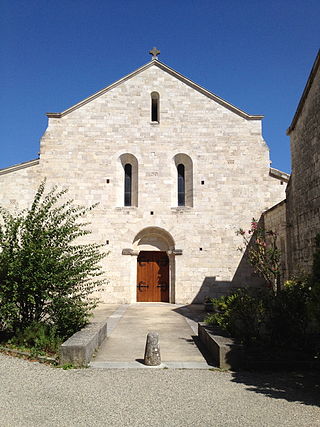
Bec Abbey, formally the Abbey of Our Lady of Bec, is a Benedictine monastic foundation in the Eure département, in the Bec valley midway between the cities of Rouen and Bernay. It is located in Le Bec Hellouin, Normandy, France, and was the most influential abbey of the 12th-century Anglo-Norman kingdom.

The Trappists, officially known as the Order of Cistercians of the Strict Observance and originally named the Order of Reformed Cistercians of Our Lady of La Trappe, are a Catholic religious order of cloistered monastics that branched off from the Cistercians. They follow the Rule of Saint Benedict and have communities of both monks and nuns that are known as Trappists and Trappistines, respectively. They are named after La Trappe Abbey, the monastery from which the movement and religious order originated. The movement first began with the reforms that Abbot Armand Jean le Bouthillier de Rancé introduced in 1664, later leading to the creation of Trappist congregations, and eventually the formal constitution as a separate religious order in 1892.

Oka is a semi-soft washed rind cheese that was originally manufactured by Trappist monks located in Oka, Quebec, Canada. The cheese is named after the town. It has a distinct flavour and aroma, and is still manufactured in Oka, although now by a commercial company. The recipe was sold in 1981 by Les Pères Trappistes to the Agropur cooperative.

Val-Dieu Abbey is a former Cistercian monastery in Wallonia in the Berwinne valley near Aubel in the Pays de Herve.

The Abbey of Notre-Dame des Neiges or Our Lady of the Snows is a Trappist monastery in the Ardèche département of south-central France. It was built in 1850, located on the territory of the commune of Saint-Laurent-les-Bains, about one and a half miles east of the village of La Bastide-Puylaurent (Lozère).

Aiguebelle Abbey is a Trappist monastery situated in the communes of Montjoyer and Réauville in the département of Drôme, on the borders of the Dauphiné and of Provence, France.

Saignon is a commune in the Vaucluse department in the Provence-Alpes-Côte d'Azur region in southeastern France. The nearest town is Apt.

Sept-Fons Abbey, Notre-Dame de Sept-Fons or Notre-Dame de Saint-Lieu Sept-Fons is a Trappist monastery at Diou in Bourbonnais in the diocese of Moulins in France. Around ninety monks currently live in the monastery, many of whom are novices sent from monasteries around the world.

Cistercian nuns are female members of the Cistercian Order, a religious order belonging to the Roman Catholic branch of the Catholic Church.
The Abbey of Notre-Dame du Lac, known as the Oka Abbey, was a Trappist Cistercian monastery located in Oka, Quebec. The main monastery building is of grey stone; it has a dozen outbuildings, all of which are situated on a 270-hectare property. With a decline in the number of monks by the early 21st century, the monastery decided to end operations there and established a non-profit centre at the abbey to preserve the site's heritage.

Fontgombault Abbey, otherwise the Abbey of Notre-Dame, Fontgombault, is a Benedictine monastery of the Solesmes Congregation located in Fontgombault in the département of Indre, in the province of Berry, France. It was built in the Romanesque architectural style. The monastery, founded in 1091, was dissolved in 1791 and refounded in 1948.

La Trappe Abbey, also known as La Grande Trappe, is a monastery in Soligny-la-Trappe, Orne, France. It is known for being the house of origin of the Trappists, to whom it gave its name.

Scourmont Abbey is a Trappist monastery on the Scourmont plateau, in the village of Forges which is part of Chimay in the province of Hainaut, Belgium. The abbey is famous for its spiritual life and for running the Chimay Brewery, one of the few producers of Trappist beer.

Ferdinand de Géramb was an Ungro-French supposed nobleman, military officer, courtier, adventurer and later Trappist monk and religious author. He served as lieutenant-general in the Austrian army, chamberlain to the Austrian Emperor and titular abbot and Bursar-general of the Trappist order.

Melleray Abbey was a Cistercian monastery, founded about the year 1134. It was situated in La Meilleraye-de-Bretagne in the vicinity of Châteaubriant in Brittany, in the present Loire-Atlantique, France, and in the Diocese of Nantes. Between 1817 and 2016 it was a house of Trappist monks. Since 2016 it has been used by the Chemin Neuf Community.

Igny Abbey or Val d'Igny Abbey is a Cistercian abbey located in Arcis-le-Ponsart, Marne, France. It was founded in 1128 for Cistercian monks, dissolved in 1791 during the French Revolution, re-established in 1876 for Trappist monks, destroyed in 1918, reopened in 1929 for Trappist nuns and modernised in 2008–12 to accommodate three or four pre-existing communities.

Évron Abbey is a former Benedictine abbey in Évron, in the Mayenne department in France. Its foundation is ascribed to the 7th century. It was dissolved in 1791 during the French Revolution. The former monastic church survived intact, and is now the Basilica of Notre-Dame de l'Épine.

Dalon Abbey is a former Cistercian monastery in Sainte-Trie, Dordogne, southwestern France. It is listed as a Historic Monument.





















